It's exciting, watching this cycle of life. I've seen it before, in detail, even giving up sleep in order to not miss a single step. And when I get the chance to see it again, I take it. Yesterday, I noticed the chrysalides had started to turn dark, so I brought them into our house and attached them to a stick inside a punch bowl.
I've actually raised monarchs this way before, from the caterpillar to adult stage, with 100% success. I had no reason to think that these two chrysalides wouldn't have adult butterflies emerging from them when the time was right. But sometimes things go wrong. Things you never expect and didn't know could happen.
This morning, I noticed a thin, white thread hanging from the zinnia chrysalis. I thought nothing of it, thinking it was a cobweb or something. I pulled it away. Later in the day, I noticed another white thread hanging from the same chrysalis. Only something alive could be doing this, but I didn't see anything.
I went to the internet to research.
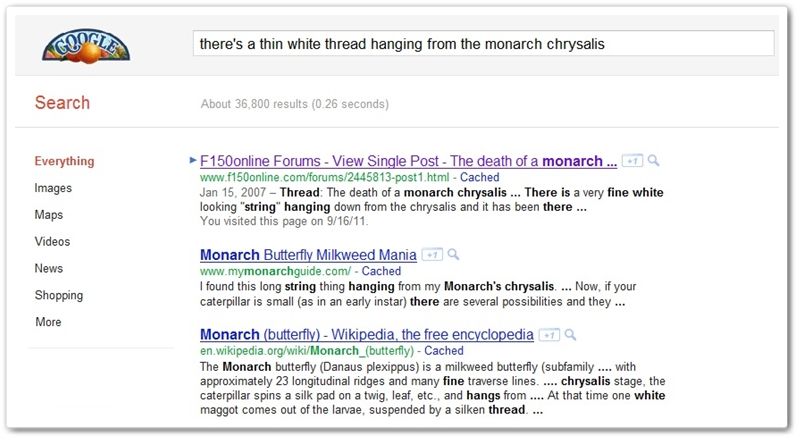 |
| Click on image to enlarge |
It didn't take long to find out that something was wrong and that this monarch would not be emerging alive. One of the monarch's natural predators is the tachinid fly. At various stages in development, the tachinid fly can lay eggs in the monarch caterpillar, or it can even lay them in the monarch when it's only a tiny egg on the leaf. The monarch continues to develop, unaware that it's been parasitized.
 |
| Tachinid fly (from Wikimedia Commons) |
Undisturbed, the tachinid eventually emerges from the chrysalis just as it did with ours. I found two reddish-brown pupae on the bottom of the bowl, along with one white maggot. I crushed the pupae and the maggot, once I learned what they were. It's highly unlikely that the adult butterfly will continue to develop now.
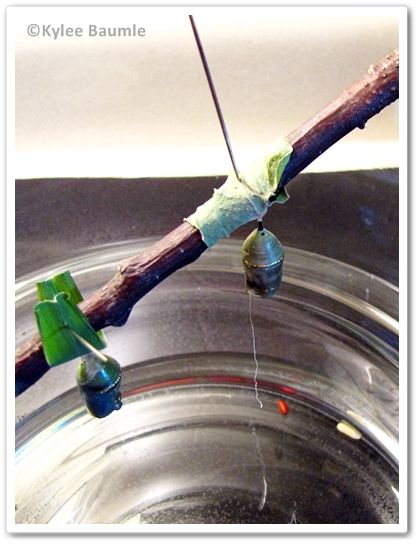 |
| You can see the white thread hanging from the chrysalis, as well as one of the reddish brown pupa cases and the maggot in the bottom of the bowl. |
As if that didn't make me sad enough, I noticed a clear liquid coming from a spot on the daylily chrysalis. I noticed this when I brought it in, but thought it was dew or something. I fear that the same fate awaits this chrysalis, too.
Nothing I did caused this. And there was nothing I could do to prevent it. It just drove home the dangers that these creatures face - dangers that make protecting their habitats even more important. The monarch populations have been dwindling over the years, due to natural disasters, predators, and mostly from disappearing habitat. The first two, we can do nothing about, but the third, we can.
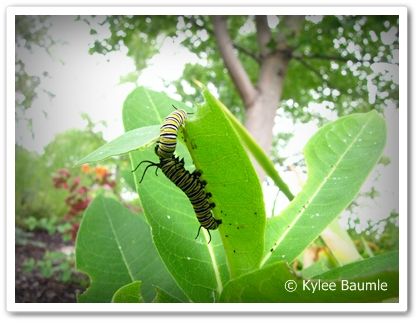 |
| These two monarch caterpillars on common milkweed (Asclepias syriaca) in my garden were actually fighting and I had to separate them. There's enough milkweed for everyone! |
I do allow common milkweed to grow in my gardens to some extent. No, I don't like its appearance as a plant, and if it came up in greater quantity than it does, I would likely pull some. But when swamp milkweed (Asclepias incarnata) comes up, it stays. I purposely grow butterfly weed (Asclepias tuberosa) in both orange and yellow forms. Monarchs live and grow in my gardens and I like it that way.
I know there are other chrysalides in my gardens, even though I don't know where they are. Monarch caterpillars will sometimes crawl 30 feet away from the milkweed on which they have been feeding to a protected location to form a chrysalis. I feel lucky when I find one, let alone two.
But this is not a lucky day. I know it's all part of life, this death by predator stuff. But I don't like it and I'm sad. Not that I didn't get to see two monarchs as they begin their lives as butterflies, but because it's two fewer butterflies that will live to fly to Mexico and back again next spring. Two fewer butterflies to start the process all over again.
Each monarch will lay approximately 500 eggs over the course of their short lives. If there are five generations of monarch in a single summer and each monarch lays 500 eggs, and each one of those lays 500 eggs (and so on), you don't really have to do much math to figure out how many monarchs there won't be because the tachinid flies decided to use the monarchs to carry on their own life cycle inside them.
On the other hand, thank goodness they do lay so many eggs. Predators will do their thing, but many will survive and live out their days the way they were intended and we will be here to enjoy them.
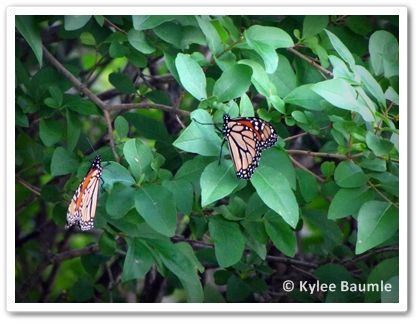 |
| Migrating monarchs seen in our yard earlier this week. |










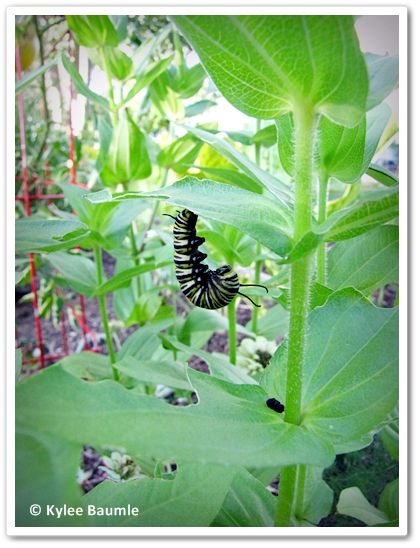
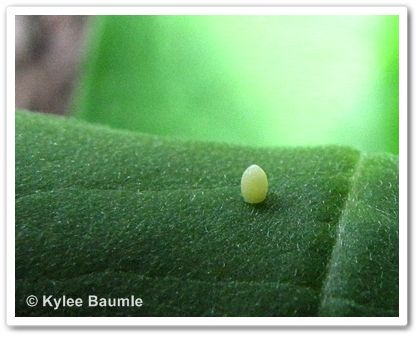






 "Bejeweled"
"Bejeweled"



14 comments:
The thing I find so frustrating, is that often the tachinid that attacks a lot of our native beauties, is an import - Compsilura concinnata - which was imported to try to control various pests. It's played havoc with a number of our butterfly and moth species.
your butterfly knowledge amazes me.
Michael ~ From what I can find out, it's the Archytas genus that gets the monarchs. But I hear what you're saying. We humans have messed up our fair share of ecological balances, haven't we?
barbara ~ This is what gardening has done for me - instilled such a thirst for knowledge about so many related subjects! Monarchs are a passion of mine, though, if you can't tell. :-)
Aww...That stinks.
AMAZING, you've inspired us to look after a caterpillar. Having a lot of trouble figuring out what it is. Wonder what we will end up with in the end, so many possibilities - wasp, fly, butterfly, moth....
I love your wealth of monarch knowledge and look forward to when you share... even when it's a sad post. I wasn't aware of the tachinid fly being a danger to monarchs. It makes me wonder what the predator of the tachinid fly is and what you could use to attract that predator to your garden.
Cindy at Rosehaven Cottage
Fern ~ I know. :-( I need to take them outside, but I keep thinking maybe there's a chance for one of them still.
Kirsty ~ Do you have a photo of it? Maybe I could help you figure it out!
Cindy ~ Monarchs are a passion of mine and I wanted to learn more about this. Tachinid flies have been used to try and control moth pests, but what they've found is that they also attack things like monarchs and the Cecropia moth. In the case of the Cecropia, they think it may be a reason that their numbers are way down. :-( We think we're helping and then we find out that maybe we aren't. How many times has that happened?
There's a little " Wise " Bug that informed me it was your birthday. Happy Birthday!!! I hope life will feel like one huge celebration for you during the entire coming year!
Exceptional read!
Thankyou for this article. I woke up this morning and checked on my caterpillar. I noticed he was hanging upside down but my excitement quickly turned to concern when I seen green goo coming from him..and a maggot crawling around my jar... I have another one in his Cacoon and hes doing fine. Its just sad...
Thankyou for this article. I woke up this morning noticing my second caterpillar (seperate jar) has turned upside down yay. When I went back and looked I noticed green too then j continued to watch and there it was a.damn maggot crawling around. Its sad... ive done this so many times and this is the.first fine it has happened.
Stacie ~ I'm SO sorry. :-( I hate when things like this happen. Last year was my first experience with it, too. I've seen several monarch butterflies and caterpillars in the garden these past few weeks, but I haven't brought any in yet. Now I'm afraid to do it because if the fly has gotten to it, I don't want to know. Too sad...
Super post Kylee! I have a registered Monarch Waystation here in central VA and have raised over 1200 monarchs over the past four years. With the dramatic decline, I raised only three here last year, as only one female adult flew through.
As I read your post, I wonder if you would/could save me some milkweed seed varieties this season that I could propagate here. I only have tropical milkweed (which the oleander aphid adores)...and I detest.
I tried some seed from Idaho and it did not do well. I have TM seed, yet would love to try some of your others for next season. Thanks, Diane
Post a Comment